Implementing Knowledge Management: A Portfolio for Telstra (MBA632)
VerifiedAdded on 2023/04/26
|10
|2598
|134
Project
AI Summary
This portfolio, prepared by a student, analyzes the knowledge management practices of Telstra, a major telecommunications company in Australia. The paper identifies weaknesses in Telstra's current knowledge management systems, particularly the lack of integration, and proposes a comprehensive strategy for improvement. The student recommends implementing both supply-side and network-based knowledge management strategies, emphasizing the importance of communication, technology, and organizational culture. The portfolio outlines specific goals, including providing accessible and reliable information, fostering a common understanding among employees, and enabling Telstra's success. It details an implementation roadmap, including piloting, roll-out, and measurement phases, with a focus on performance measurement tools and key performance indicators. The recommendations include leveraging tools such as knowledge retention tools, knowledge mapping, and communities of practice to enhance knowledge sharing and organizational learning. The portfolio concludes by emphasizing the need for a systematic approach to knowledge management, and suggests utilizing a corporate directory and organizational learning processes to improve overall performance.
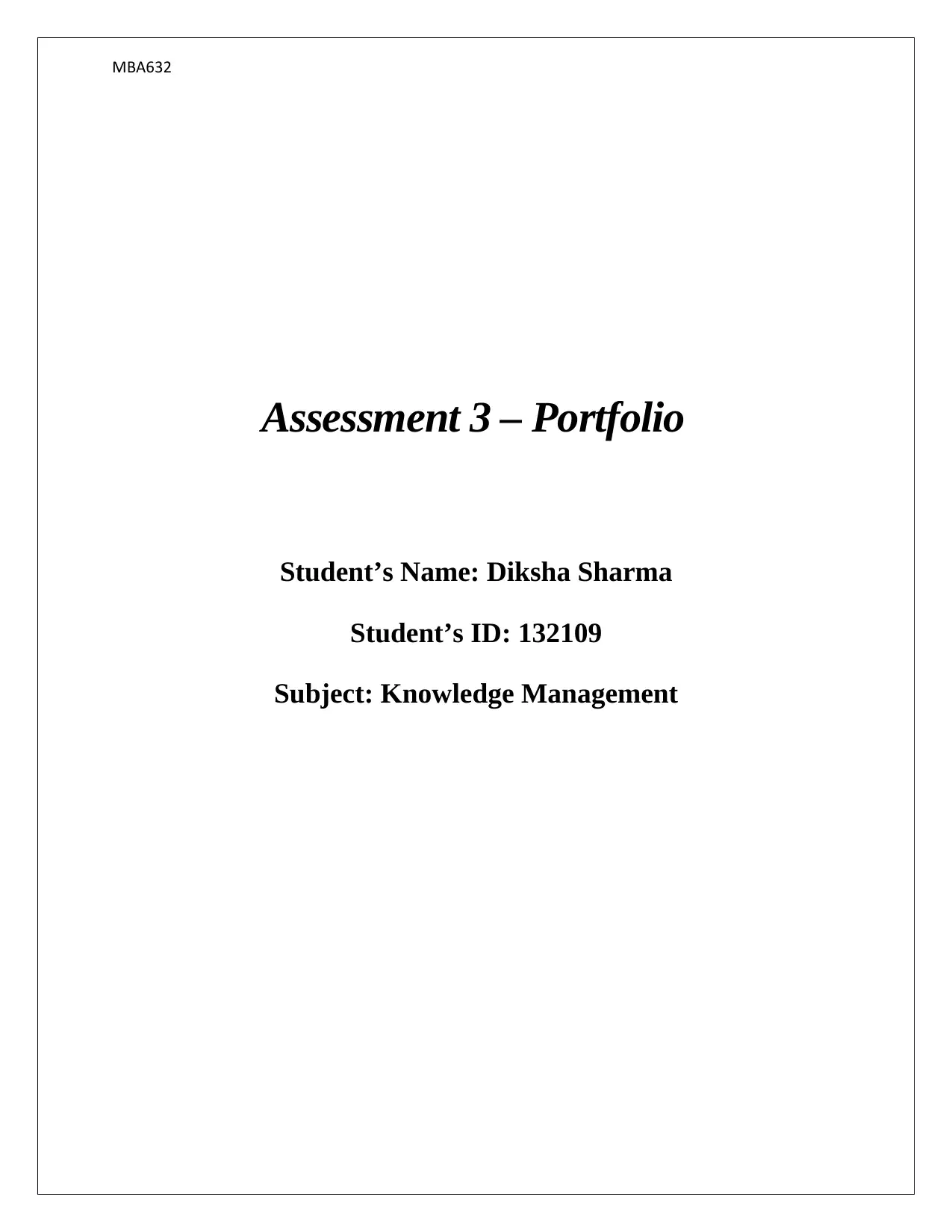
MBA632
Assessment 3 – Portfolio
Student’s Name: Diksha Sharma
Student’s ID: 132109
Subject: Knowledge Management
Assessment 3 – Portfolio
Student’s Name: Diksha Sharma
Student’s ID: 132109
Subject: Knowledge Management
Paraphrase This Document
Need a fresh take? Get an instant paraphrase of this document with our AI Paraphraser
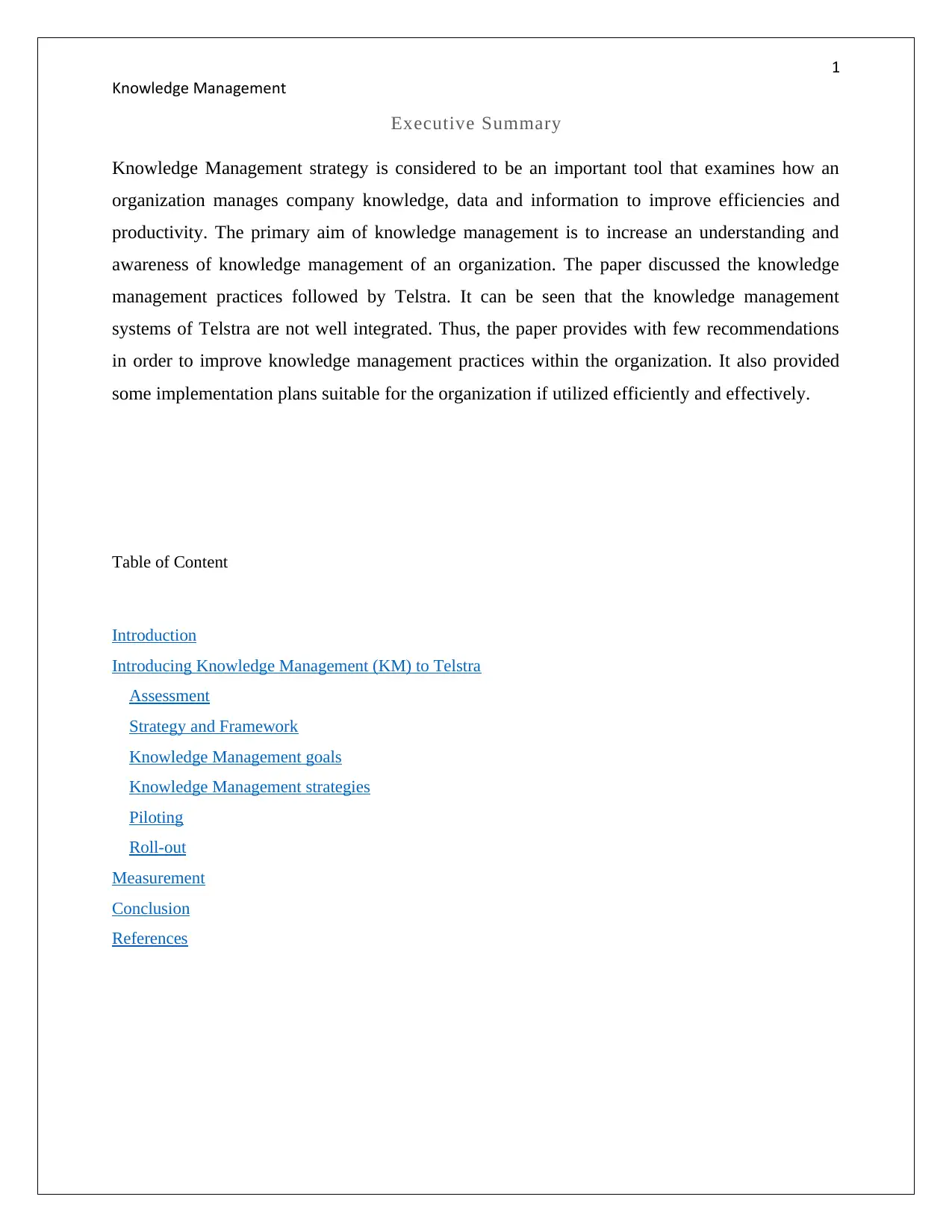
1
Knowledge Management
Executive Summary
Knowledge Management strategy is considered to be an important tool that examines how an
organization manages company knowledge, data and information to improve efficiencies and
productivity. The primary aim of knowledge management is to increase an understanding and
awareness of knowledge management of an organization. The paper discussed the knowledge
management practices followed by Telstra. It can be seen that the knowledge management
systems of Telstra are not well integrated. Thus, the paper provides with few recommendations
in order to improve knowledge management practices within the organization. It also provided
some implementation plans suitable for the organization if utilized efficiently and effectively.
Table of Content
Introduction
Introducing Knowledge Management (KM) to Telstra
Assessment
Strategy and Framework
Knowledge Management goals
Knowledge Management strategies
Piloting
Roll-out
Measurement
Conclusion
References
Knowledge Management
Executive Summary
Knowledge Management strategy is considered to be an important tool that examines how an
organization manages company knowledge, data and information to improve efficiencies and
productivity. The primary aim of knowledge management is to increase an understanding and
awareness of knowledge management of an organization. The paper discussed the knowledge
management practices followed by Telstra. It can be seen that the knowledge management
systems of Telstra are not well integrated. Thus, the paper provides with few recommendations
in order to improve knowledge management practices within the organization. It also provided
some implementation plans suitable for the organization if utilized efficiently and effectively.
Table of Content
Introduction
Introducing Knowledge Management (KM) to Telstra
Assessment
Strategy and Framework
Knowledge Management goals
Knowledge Management strategies
Piloting
Roll-out
Measurement
Conclusion
References
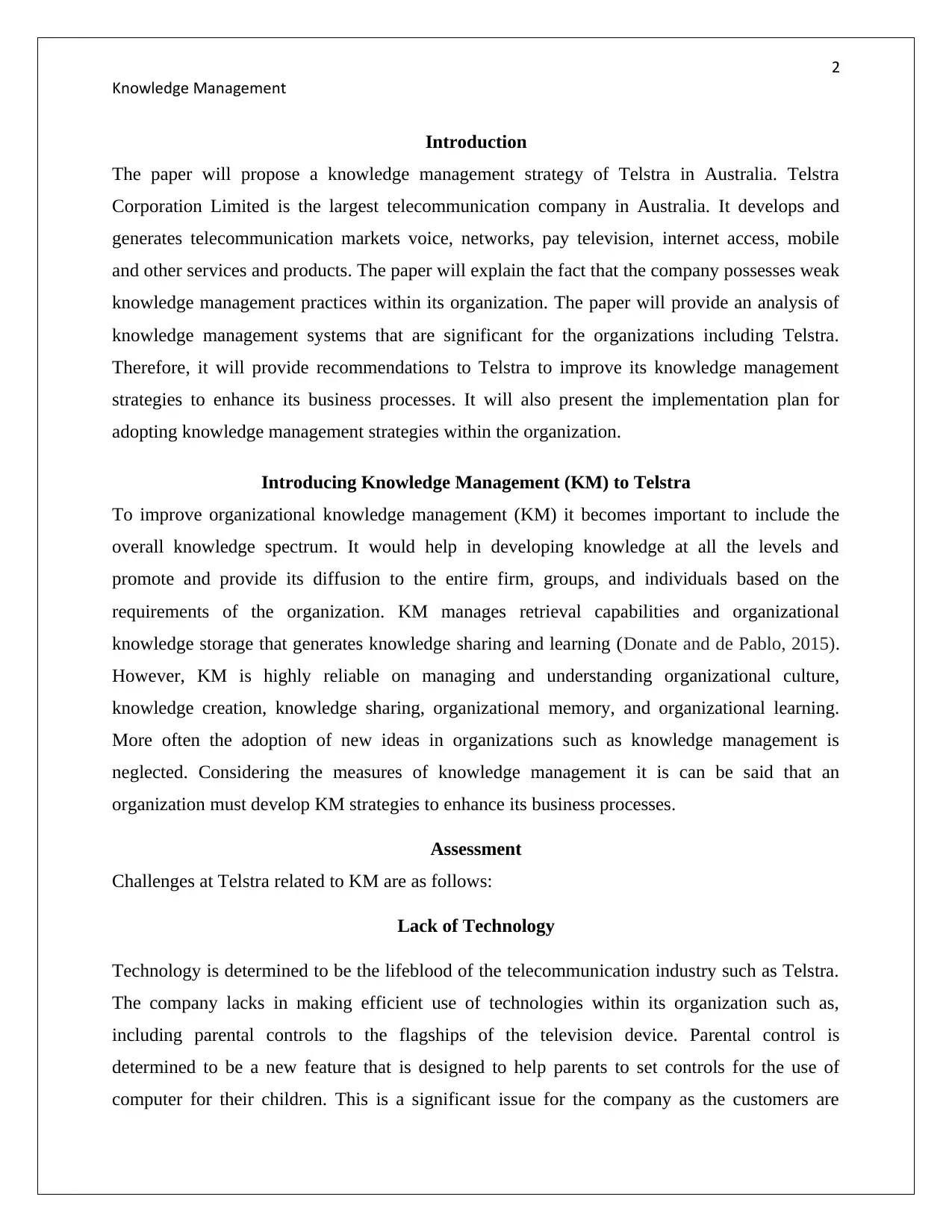
2
Knowledge Management
Introduction
The paper will propose a knowledge management strategy of Telstra in Australia. Telstra
Corporation Limited is the largest telecommunication company in Australia. It develops and
generates telecommunication markets voice, networks, pay television, internet access, mobile
and other services and products. The paper will explain the fact that the company possesses weak
knowledge management practices within its organization. The paper will provide an analysis of
knowledge management systems that are significant for the organizations including Telstra.
Therefore, it will provide recommendations to Telstra to improve its knowledge management
strategies to enhance its business processes. It will also present the implementation plan for
adopting knowledge management strategies within the organization.
Introducing Knowledge Management (KM) to Telstra
To improve organizational knowledge management (KM) it becomes important to include the
overall knowledge spectrum. It would help in developing knowledge at all the levels and
promote and provide its diffusion to the entire firm, groups, and individuals based on the
requirements of the organization. KM manages retrieval capabilities and organizational
knowledge storage that generates knowledge sharing and learning (Donate and de Pablo, 2015).
However, KM is highly reliable on managing and understanding organizational culture,
knowledge creation, knowledge sharing, organizational memory, and organizational learning.
More often the adoption of new ideas in organizations such as knowledge management is
neglected. Considering the measures of knowledge management it is can be said that an
organization must develop KM strategies to enhance its business processes.
Assessment
Challenges at Telstra related to KM are as follows:
Lack of Technology
Technology is determined to be the lifeblood of the telecommunication industry such as Telstra.
The company lacks in making efficient use of technologies within its organization such as,
including parental controls to the flagships of the television device. Parental control is
determined to be a new feature that is designed to help parents to set controls for the use of
computer for their children. This is a significant issue for the company as the customers are
Knowledge Management
Introduction
The paper will propose a knowledge management strategy of Telstra in Australia. Telstra
Corporation Limited is the largest telecommunication company in Australia. It develops and
generates telecommunication markets voice, networks, pay television, internet access, mobile
and other services and products. The paper will explain the fact that the company possesses weak
knowledge management practices within its organization. The paper will provide an analysis of
knowledge management systems that are significant for the organizations including Telstra.
Therefore, it will provide recommendations to Telstra to improve its knowledge management
strategies to enhance its business processes. It will also present the implementation plan for
adopting knowledge management strategies within the organization.
Introducing Knowledge Management (KM) to Telstra
To improve organizational knowledge management (KM) it becomes important to include the
overall knowledge spectrum. It would help in developing knowledge at all the levels and
promote and provide its diffusion to the entire firm, groups, and individuals based on the
requirements of the organization. KM manages retrieval capabilities and organizational
knowledge storage that generates knowledge sharing and learning (Donate and de Pablo, 2015).
However, KM is highly reliable on managing and understanding organizational culture,
knowledge creation, knowledge sharing, organizational memory, and organizational learning.
More often the adoption of new ideas in organizations such as knowledge management is
neglected. Considering the measures of knowledge management it is can be said that an
organization must develop KM strategies to enhance its business processes.
Assessment
Challenges at Telstra related to KM are as follows:
Lack of Technology
Technology is determined to be the lifeblood of the telecommunication industry such as Telstra.
The company lacks in making efficient use of technologies within its organization such as,
including parental controls to the flagships of the television device. Parental control is
determined to be a new feature that is designed to help parents to set controls for the use of
computer for their children. This is a significant issue for the company as the customers are
⊘ This is a preview!⊘
Do you want full access?
Subscribe today to unlock all pages.

Trusted by 1+ million students worldwide
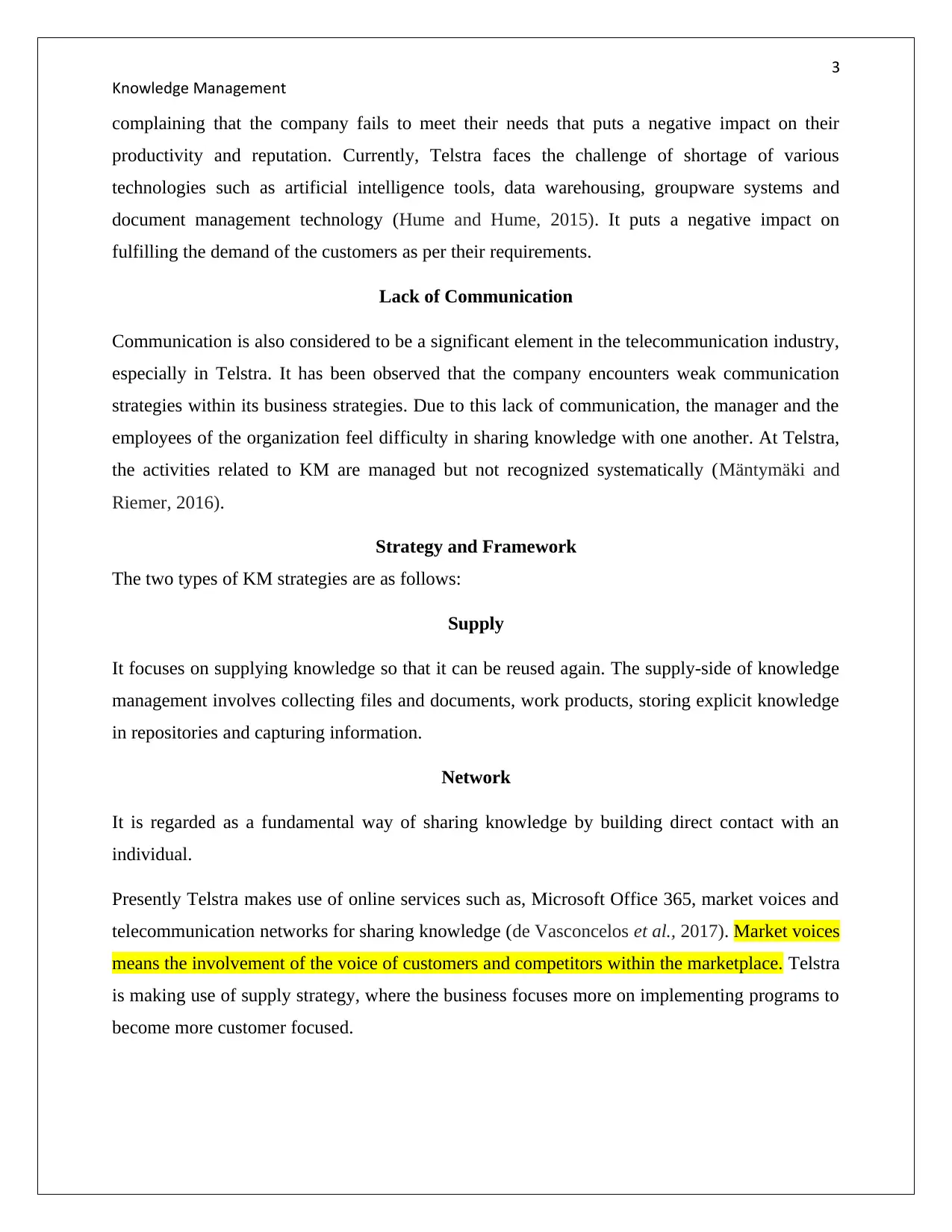
3
Knowledge Management
complaining that the company fails to meet their needs that puts a negative impact on their
productivity and reputation. Currently, Telstra faces the challenge of shortage of various
technologies such as artificial intelligence tools, data warehousing, groupware systems and
document management technology (Hume and Hume, 2015). It puts a negative impact on
fulfilling the demand of the customers as per their requirements.
Lack of Communication
Communication is also considered to be a significant element in the telecommunication industry,
especially in Telstra. It has been observed that the company encounters weak communication
strategies within its business strategies. Due to this lack of communication, the manager and the
employees of the organization feel difficulty in sharing knowledge with one another. At Telstra,
the activities related to KM are managed but not recognized systematically (Mäntymäki and
Riemer, 2016).
Strategy and Framework
The two types of KM strategies are as follows:
Supply
It focuses on supplying knowledge so that it can be reused again. The supply-side of knowledge
management involves collecting files and documents, work products, storing explicit knowledge
in repositories and capturing information.
Network
It is regarded as a fundamental way of sharing knowledge by building direct contact with an
individual.
Presently Telstra makes use of online services such as, Microsoft Office 365, market voices and
telecommunication networks for sharing knowledge (de Vasconcelos et al., 2017). Market voices
means the involvement of the voice of customers and competitors within the marketplace. Telstra
is making use of supply strategy, where the business focuses more on implementing programs to
become more customer focused.
Knowledge Management
complaining that the company fails to meet their needs that puts a negative impact on their
productivity and reputation. Currently, Telstra faces the challenge of shortage of various
technologies such as artificial intelligence tools, data warehousing, groupware systems and
document management technology (Hume and Hume, 2015). It puts a negative impact on
fulfilling the demand of the customers as per their requirements.
Lack of Communication
Communication is also considered to be a significant element in the telecommunication industry,
especially in Telstra. It has been observed that the company encounters weak communication
strategies within its business strategies. Due to this lack of communication, the manager and the
employees of the organization feel difficulty in sharing knowledge with one another. At Telstra,
the activities related to KM are managed but not recognized systematically (Mäntymäki and
Riemer, 2016).
Strategy and Framework
The two types of KM strategies are as follows:
Supply
It focuses on supplying knowledge so that it can be reused again. The supply-side of knowledge
management involves collecting files and documents, work products, storing explicit knowledge
in repositories and capturing information.
Network
It is regarded as a fundamental way of sharing knowledge by building direct contact with an
individual.
Presently Telstra makes use of online services such as, Microsoft Office 365, market voices and
telecommunication networks for sharing knowledge (de Vasconcelos et al., 2017). Market voices
means the involvement of the voice of customers and competitors within the marketplace. Telstra
is making use of supply strategy, where the business focuses more on implementing programs to
become more customer focused.
Paraphrase This Document
Need a fresh take? Get an instant paraphrase of this document with our AI Paraphraser
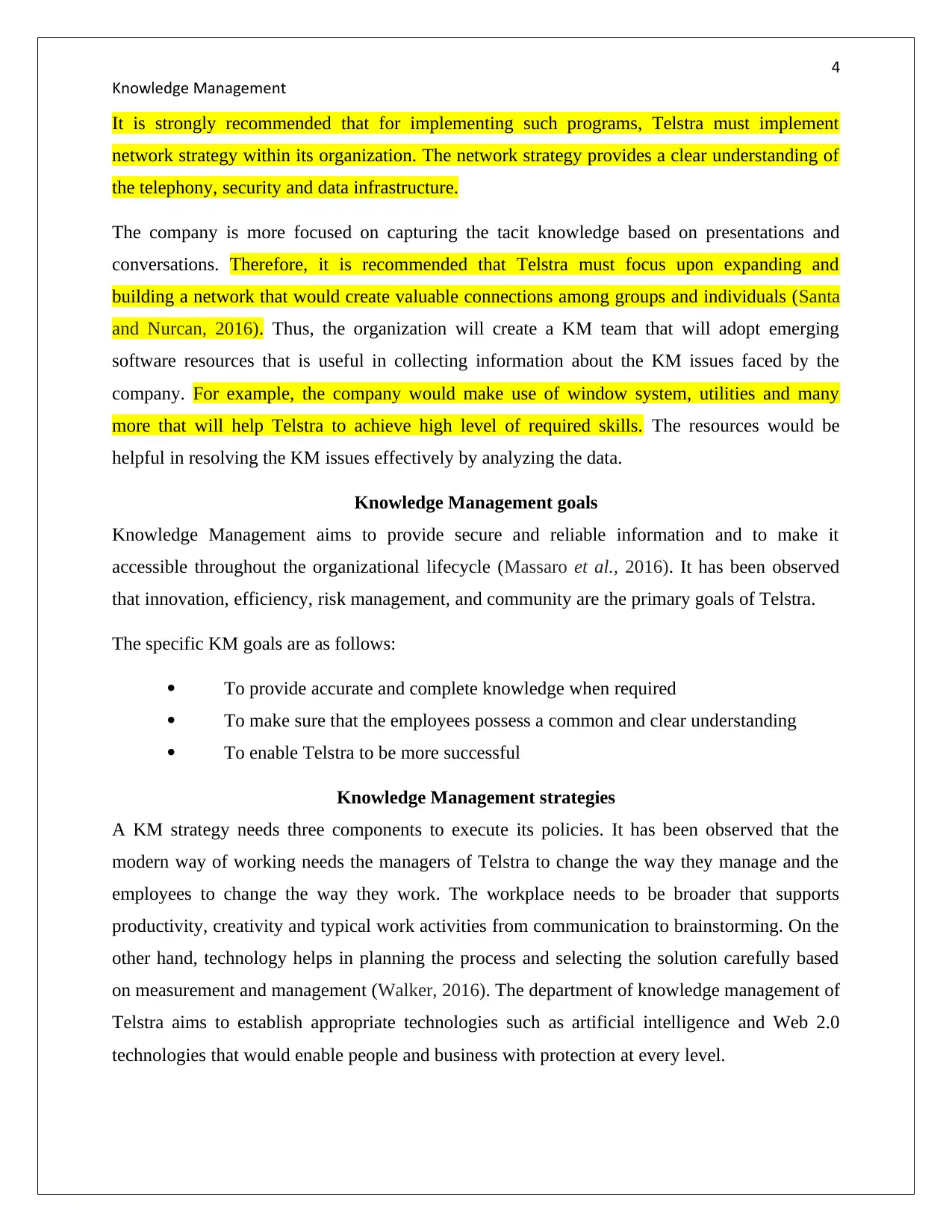
4
Knowledge Management
It is strongly recommended that for implementing such programs, Telstra must implement
network strategy within its organization. The network strategy provides a clear understanding of
the telephony, security and data infrastructure.
The company is more focused on capturing the tacit knowledge based on presentations and
conversations. Therefore, it is recommended that Telstra must focus upon expanding and
building a network that would create valuable connections among groups and individuals (Santa
and Nurcan, 2016). Thus, the organization will create a KM team that will adopt emerging
software resources that is useful in collecting information about the KM issues faced by the
company. For example, the company would make use of window system, utilities and many
more that will help Telstra to achieve high level of required skills. The resources would be
helpful in resolving the KM issues effectively by analyzing the data.
Knowledge Management goals
Knowledge Management aims to provide secure and reliable information and to make it
accessible throughout the organizational lifecycle (Massaro et al., 2016). It has been observed
that innovation, efficiency, risk management, and community are the primary goals of Telstra.
The specific KM goals are as follows:
To provide accurate and complete knowledge when required
To make sure that the employees possess a common and clear understanding
To enable Telstra to be more successful
Knowledge Management strategies
A KM strategy needs three components to execute its policies. It has been observed that the
modern way of working needs the managers of Telstra to change the way they manage and the
employees to change the way they work. The workplace needs to be broader that supports
productivity, creativity and typical work activities from communication to brainstorming. On the
other hand, technology helps in planning the process and selecting the solution carefully based
on measurement and management (Walker, 2016). The department of knowledge management of
Telstra aims to establish appropriate technologies such as artificial intelligence and Web 2.0
technologies that would enable people and business with protection at every level.
Knowledge Management
It is strongly recommended that for implementing such programs, Telstra must implement
network strategy within its organization. The network strategy provides a clear understanding of
the telephony, security and data infrastructure.
The company is more focused on capturing the tacit knowledge based on presentations and
conversations. Therefore, it is recommended that Telstra must focus upon expanding and
building a network that would create valuable connections among groups and individuals (Santa
and Nurcan, 2016). Thus, the organization will create a KM team that will adopt emerging
software resources that is useful in collecting information about the KM issues faced by the
company. For example, the company would make use of window system, utilities and many
more that will help Telstra to achieve high level of required skills. The resources would be
helpful in resolving the KM issues effectively by analyzing the data.
Knowledge Management goals
Knowledge Management aims to provide secure and reliable information and to make it
accessible throughout the organizational lifecycle (Massaro et al., 2016). It has been observed
that innovation, efficiency, risk management, and community are the primary goals of Telstra.
The specific KM goals are as follows:
To provide accurate and complete knowledge when required
To make sure that the employees possess a common and clear understanding
To enable Telstra to be more successful
Knowledge Management strategies
A KM strategy needs three components to execute its policies. It has been observed that the
modern way of working needs the managers of Telstra to change the way they manage and the
employees to change the way they work. The workplace needs to be broader that supports
productivity, creativity and typical work activities from communication to brainstorming. On the
other hand, technology helps in planning the process and selecting the solution carefully based
on measurement and management (Walker, 2016). The department of knowledge management of
Telstra aims to establish appropriate technologies such as artificial intelligence and Web 2.0
technologies that would enable people and business with protection at every level.
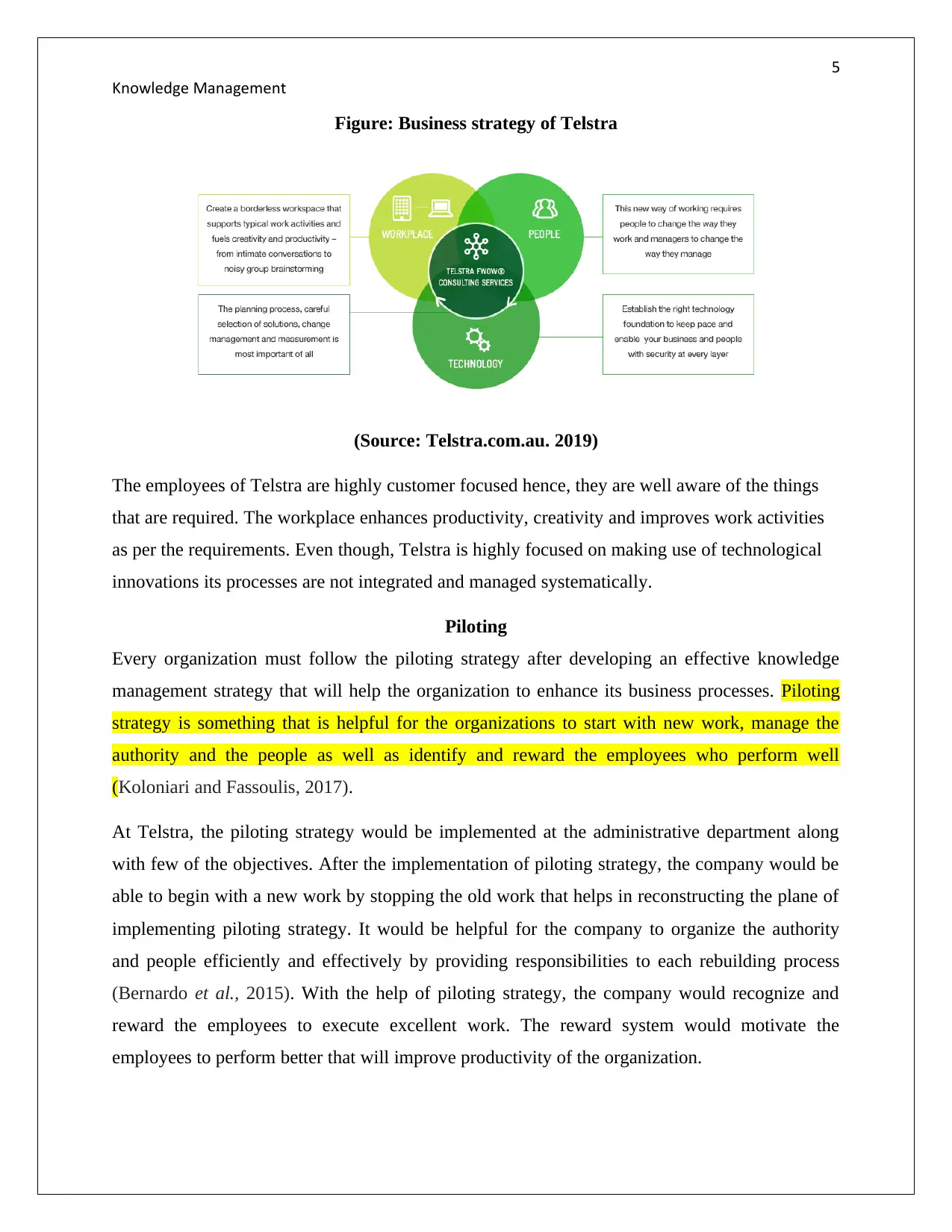
5
Knowledge Management
Figure: Business strategy of Telstra
(Source: Telstra.com.au. 2019)
The employees of Telstra are highly customer focused hence, they are well aware of the things
that are required. The workplace enhances productivity, creativity and improves work activities
as per the requirements. Even though, Telstra is highly focused on making use of technological
innovations its processes are not integrated and managed systematically.
Piloting
Every organization must follow the piloting strategy after developing an effective knowledge
management strategy that will help the organization to enhance its business processes. Piloting
strategy is something that is helpful for the organizations to start with new work, manage the
authority and the people as well as identify and reward the employees who perform well
(Koloniari and Fassoulis, 2017).
At Telstra, the piloting strategy would be implemented at the administrative department along
with few of the objectives. After the implementation of piloting strategy, the company would be
able to begin with a new work by stopping the old work that helps in reconstructing the plane of
implementing piloting strategy. It would be helpful for the company to organize the authority
and people efficiently and effectively by providing responsibilities to each rebuilding process
(Bernardo et al., 2015). With the help of piloting strategy, the company would recognize and
reward the employees to execute excellent work. The reward system would motivate the
employees to perform better that will improve productivity of the organization.
Knowledge Management
Figure: Business strategy of Telstra
(Source: Telstra.com.au. 2019)
The employees of Telstra are highly customer focused hence, they are well aware of the things
that are required. The workplace enhances productivity, creativity and improves work activities
as per the requirements. Even though, Telstra is highly focused on making use of technological
innovations its processes are not integrated and managed systematically.
Piloting
Every organization must follow the piloting strategy after developing an effective knowledge
management strategy that will help the organization to enhance its business processes. Piloting
strategy is something that is helpful for the organizations to start with new work, manage the
authority and the people as well as identify and reward the employees who perform well
(Koloniari and Fassoulis, 2017).
At Telstra, the piloting strategy would be implemented at the administrative department along
with few of the objectives. After the implementation of piloting strategy, the company would be
able to begin with a new work by stopping the old work that helps in reconstructing the plane of
implementing piloting strategy. It would be helpful for the company to organize the authority
and people efficiently and effectively by providing responsibilities to each rebuilding process
(Bernardo et al., 2015). With the help of piloting strategy, the company would recognize and
reward the employees to execute excellent work. The reward system would motivate the
employees to perform better that will improve productivity of the organization.
⊘ This is a preview!⊘
Do you want full access?
Subscribe today to unlock all pages.

Trusted by 1+ million students worldwide
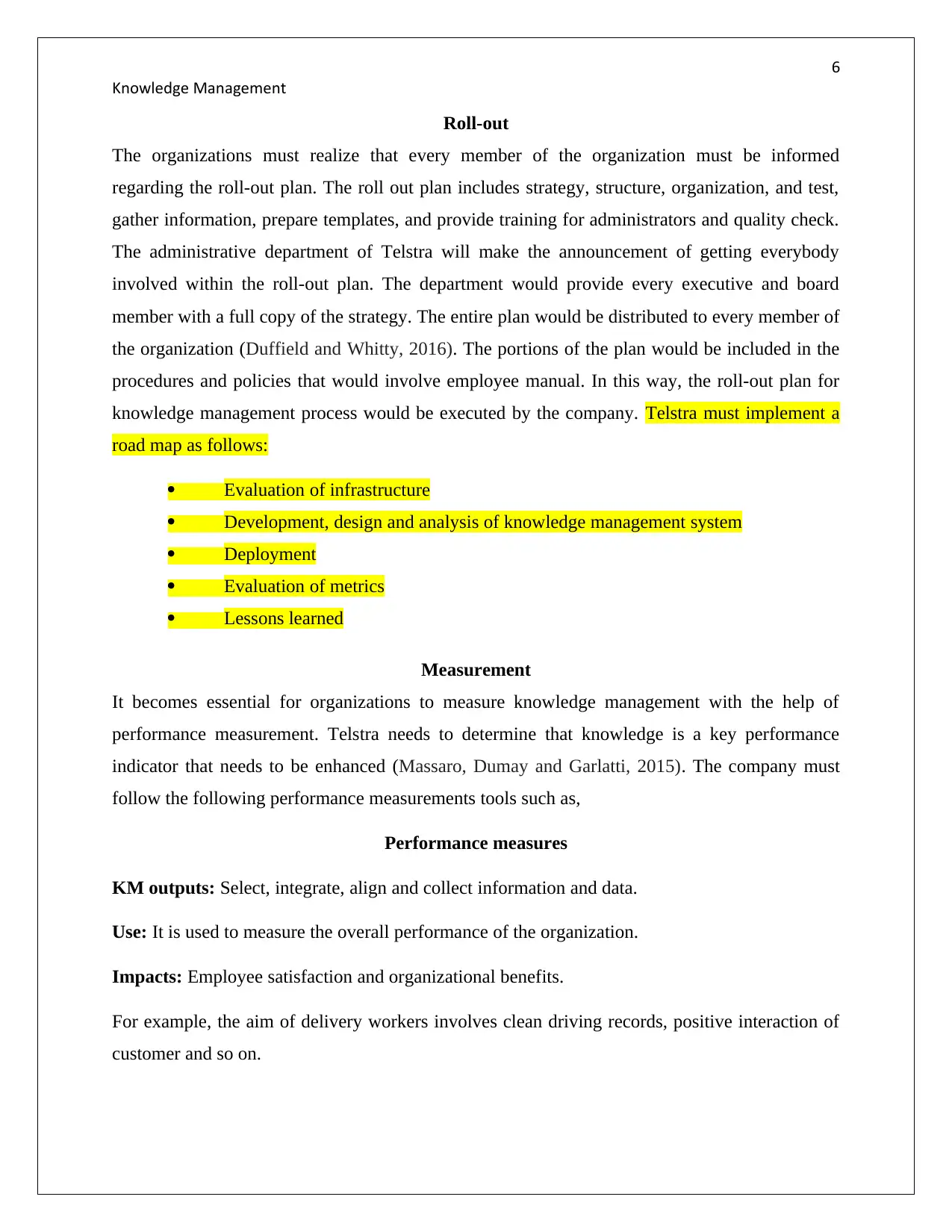
6
Knowledge Management
Roll-out
The organizations must realize that every member of the organization must be informed
regarding the roll-out plan. The roll out plan includes strategy, structure, organization, and test,
gather information, prepare templates, and provide training for administrators and quality check.
The administrative department of Telstra will make the announcement of getting everybody
involved within the roll-out plan. The department would provide every executive and board
member with a full copy of the strategy. The entire plan would be distributed to every member of
the organization (Duffield and Whitty, 2016). The portions of the plan would be included in the
procedures and policies that would involve employee manual. In this way, the roll-out plan for
knowledge management process would be executed by the company. Telstra must implement a
road map as follows:
Evaluation of infrastructure
Development, design and analysis of knowledge management system
Deployment
Evaluation of metrics
Lessons learned
Measurement
It becomes essential for organizations to measure knowledge management with the help of
performance measurement. Telstra needs to determine that knowledge is a key performance
indicator that needs to be enhanced (Massaro, Dumay and Garlatti, 2015). The company must
follow the following performance measurements tools such as,
Performance measures
KM outputs: Select, integrate, align and collect information and data.
Use: It is used to measure the overall performance of the organization.
Impacts: Employee satisfaction and organizational benefits.
For example, the aim of delivery workers involves clean driving records, positive interaction of
customer and so on.
Knowledge Management
Roll-out
The organizations must realize that every member of the organization must be informed
regarding the roll-out plan. The roll out plan includes strategy, structure, organization, and test,
gather information, prepare templates, and provide training for administrators and quality check.
The administrative department of Telstra will make the announcement of getting everybody
involved within the roll-out plan. The department would provide every executive and board
member with a full copy of the strategy. The entire plan would be distributed to every member of
the organization (Duffield and Whitty, 2016). The portions of the plan would be included in the
procedures and policies that would involve employee manual. In this way, the roll-out plan for
knowledge management process would be executed by the company. Telstra must implement a
road map as follows:
Evaluation of infrastructure
Development, design and analysis of knowledge management system
Deployment
Evaluation of metrics
Lessons learned
Measurement
It becomes essential for organizations to measure knowledge management with the help of
performance measurement. Telstra needs to determine that knowledge is a key performance
indicator that needs to be enhanced (Massaro, Dumay and Garlatti, 2015). The company must
follow the following performance measurements tools such as,
Performance measures
KM outputs: Select, integrate, align and collect information and data.
Use: It is used to measure the overall performance of the organization.
Impacts: Employee satisfaction and organizational benefits.
For example, the aim of delivery workers involves clean driving records, positive interaction of
customer and so on.
Paraphrase This Document
Need a fresh take? Get an instant paraphrase of this document with our AI Paraphraser
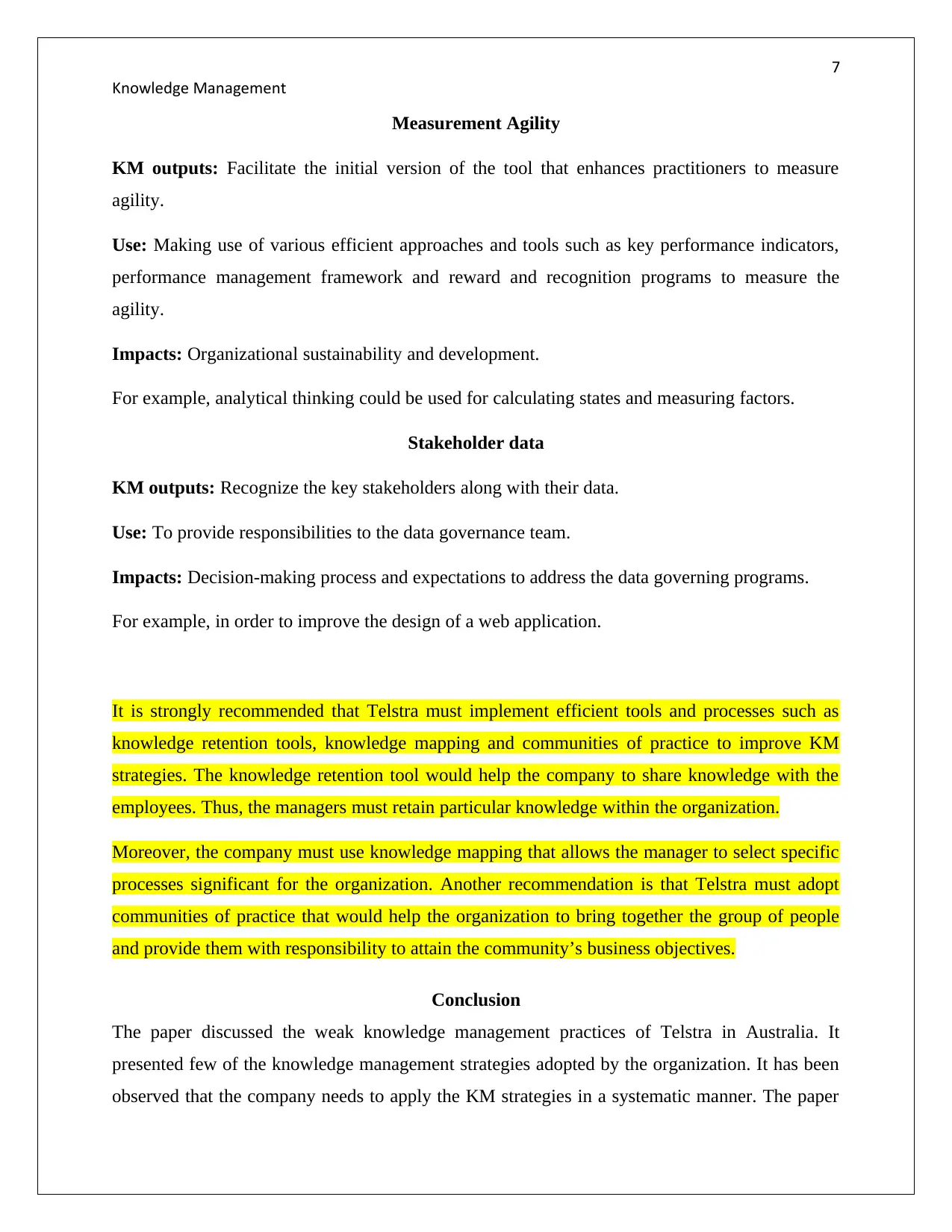
7
Knowledge Management
Measurement Agility
KM outputs: Facilitate the initial version of the tool that enhances practitioners to measure
agility.
Use: Making use of various efficient approaches and tools such as key performance indicators,
performance management framework and reward and recognition programs to measure the
agility.
Impacts: Organizational sustainability and development.
For example, analytical thinking could be used for calculating states and measuring factors.
Stakeholder data
KM outputs: Recognize the key stakeholders along with their data.
Use: To provide responsibilities to the data governance team.
Impacts: Decision-making process and expectations to address the data governing programs.
For example, in order to improve the design of a web application.
It is strongly recommended that Telstra must implement efficient tools and processes such as
knowledge retention tools, knowledge mapping and communities of practice to improve KM
strategies. The knowledge retention tool would help the company to share knowledge with the
employees. Thus, the managers must retain particular knowledge within the organization.
Moreover, the company must use knowledge mapping that allows the manager to select specific
processes significant for the organization. Another recommendation is that Telstra must adopt
communities of practice that would help the organization to bring together the group of people
and provide them with responsibility to attain the community’s business objectives.
Conclusion
The paper discussed the weak knowledge management practices of Telstra in Australia. It
presented few of the knowledge management strategies adopted by the organization. It has been
observed that the company needs to apply the KM strategies in a systematic manner. The paper
Knowledge Management
Measurement Agility
KM outputs: Facilitate the initial version of the tool that enhances practitioners to measure
agility.
Use: Making use of various efficient approaches and tools such as key performance indicators,
performance management framework and reward and recognition programs to measure the
agility.
Impacts: Organizational sustainability and development.
For example, analytical thinking could be used for calculating states and measuring factors.
Stakeholder data
KM outputs: Recognize the key stakeholders along with their data.
Use: To provide responsibilities to the data governance team.
Impacts: Decision-making process and expectations to address the data governing programs.
For example, in order to improve the design of a web application.
It is strongly recommended that Telstra must implement efficient tools and processes such as
knowledge retention tools, knowledge mapping and communities of practice to improve KM
strategies. The knowledge retention tool would help the company to share knowledge with the
employees. Thus, the managers must retain particular knowledge within the organization.
Moreover, the company must use knowledge mapping that allows the manager to select specific
processes significant for the organization. Another recommendation is that Telstra must adopt
communities of practice that would help the organization to bring together the group of people
and provide them with responsibility to attain the community’s business objectives.
Conclusion
The paper discussed the weak knowledge management practices of Telstra in Australia. It
presented few of the knowledge management strategies adopted by the organization. It has been
observed that the company needs to apply the KM strategies in a systematic manner. The paper
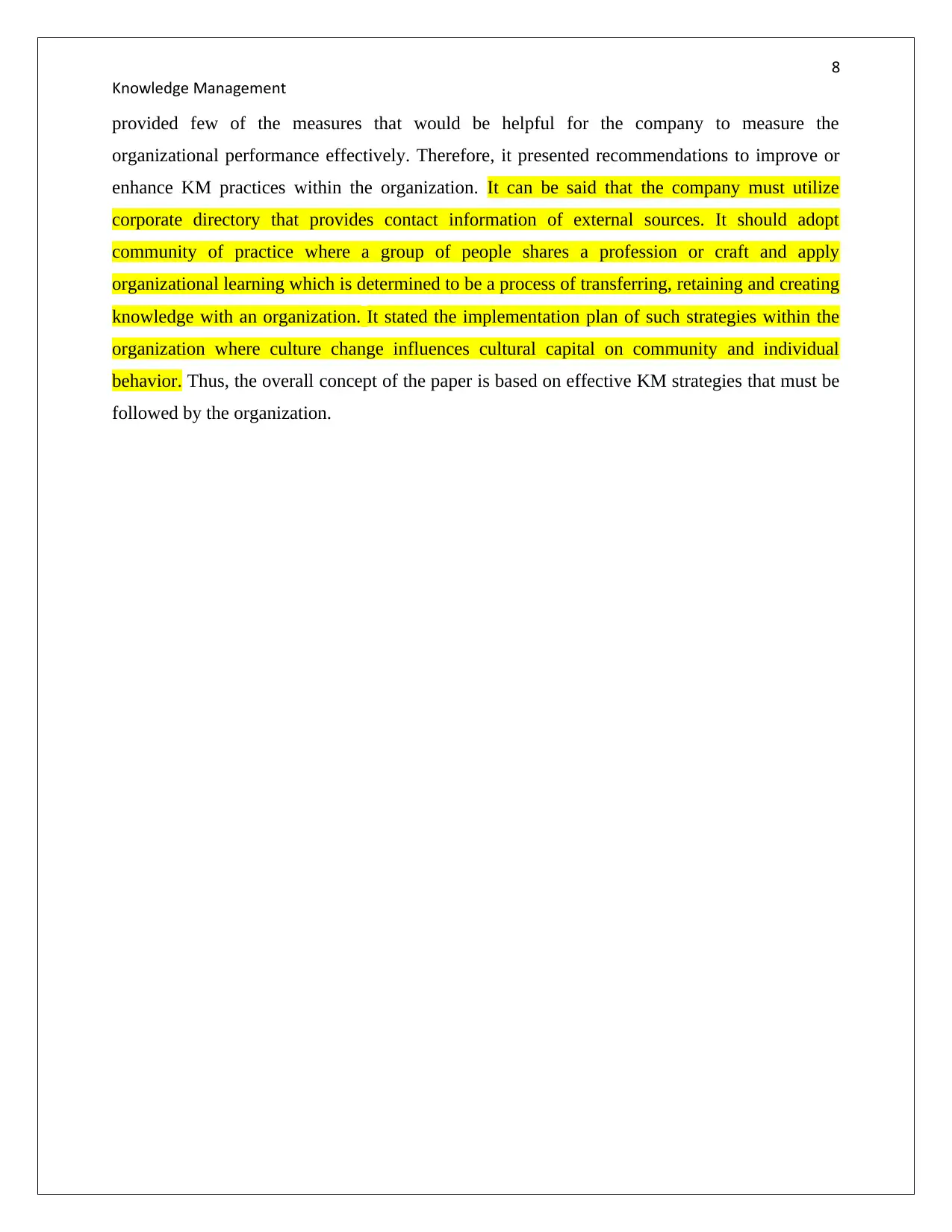
8
Knowledge Management
provided few of the measures that would be helpful for the company to measure the
organizational performance effectively. Therefore, it presented recommendations to improve or
enhance KM practices within the organization. It can be said that the company must utilize
corporate directory that provides contact information of external sources. It should adopt
community of practice where a group of people shares a profession or craft and apply
organizational learning which is determined to be a process of transferring, retaining and creating
knowledge with an organization. It stated the implementation plan of such strategies within the
organization where culture change influences cultural capital on community and individual
behavior. Thus, the overall concept of the paper is based on effective KM strategies that must be
followed by the organization.
Knowledge Management
provided few of the measures that would be helpful for the company to measure the
organizational performance effectively. Therefore, it presented recommendations to improve or
enhance KM practices within the organization. It can be said that the company must utilize
corporate directory that provides contact information of external sources. It should adopt
community of practice where a group of people shares a profession or craft and apply
organizational learning which is determined to be a process of transferring, retaining and creating
knowledge with an organization. It stated the implementation plan of such strategies within the
organization where culture change influences cultural capital on community and individual
behavior. Thus, the overall concept of the paper is based on effective KM strategies that must be
followed by the organization.
⊘ This is a preview!⊘
Do you want full access?
Subscribe today to unlock all pages.

Trusted by 1+ million students worldwide
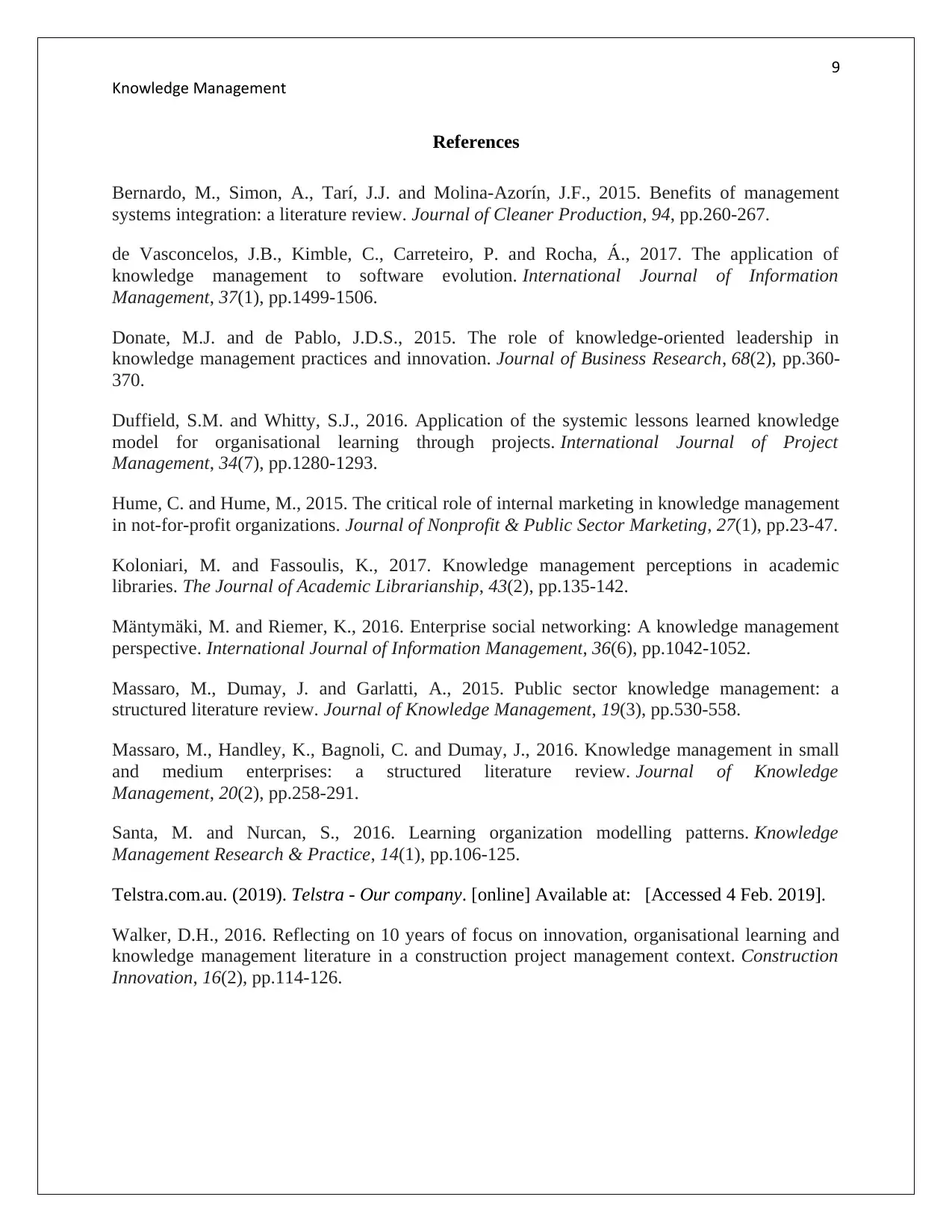
9
Knowledge Management
References
Bernardo, M., Simon, A., Tarí, J.J. and Molina-Azorín, J.F., 2015. Benefits of management
systems integration: a literature review. Journal of Cleaner Production, 94, pp.260-267.
de Vasconcelos, J.B., Kimble, C., Carreteiro, P. and Rocha, Á., 2017. The application of
knowledge management to software evolution. International Journal of Information
Management, 37(1), pp.1499-1506.
Donate, M.J. and de Pablo, J.D.S., 2015. The role of knowledge-oriented leadership in
knowledge management practices and innovation. Journal of Business Research, 68(2), pp.360-
370.
Duffield, S.M. and Whitty, S.J., 2016. Application of the systemic lessons learned knowledge
model for organisational learning through projects. International Journal of Project
Management, 34(7), pp.1280-1293.
Hume, C. and Hume, M., 2015. The critical role of internal marketing in knowledge management
in not-for-profit organizations. Journal of Nonprofit & Public Sector Marketing, 27(1), pp.23-47.
Koloniari, M. and Fassoulis, K., 2017. Knowledge management perceptions in academic
libraries. The Journal of Academic Librarianship, 43(2), pp.135-142.
Mäntymäki, M. and Riemer, K., 2016. Enterprise social networking: A knowledge management
perspective. International Journal of Information Management, 36(6), pp.1042-1052.
Massaro, M., Dumay, J. and Garlatti, A., 2015. Public sector knowledge management: a
structured literature review. Journal of Knowledge Management, 19(3), pp.530-558.
Massaro, M., Handley, K., Bagnoli, C. and Dumay, J., 2016. Knowledge management in small
and medium enterprises: a structured literature review. Journal of Knowledge
Management, 20(2), pp.258-291.
Santa, M. and Nurcan, S., 2016. Learning organization modelling patterns. Knowledge
Management Research & Practice, 14(1), pp.106-125.
Telstra.com.au. (2019). Telstra - Our company. [online] Available at: [Accessed 4 Feb. 2019].
Walker, D.H., 2016. Reflecting on 10 years of focus on innovation, organisational learning and
knowledge management literature in a construction project management context. Construction
Innovation, 16(2), pp.114-126.
Knowledge Management
References
Bernardo, M., Simon, A., Tarí, J.J. and Molina-Azorín, J.F., 2015. Benefits of management
systems integration: a literature review. Journal of Cleaner Production, 94, pp.260-267.
de Vasconcelos, J.B., Kimble, C., Carreteiro, P. and Rocha, Á., 2017. The application of
knowledge management to software evolution. International Journal of Information
Management, 37(1), pp.1499-1506.
Donate, M.J. and de Pablo, J.D.S., 2015. The role of knowledge-oriented leadership in
knowledge management practices and innovation. Journal of Business Research, 68(2), pp.360-
370.
Duffield, S.M. and Whitty, S.J., 2016. Application of the systemic lessons learned knowledge
model for organisational learning through projects. International Journal of Project
Management, 34(7), pp.1280-1293.
Hume, C. and Hume, M., 2015. The critical role of internal marketing in knowledge management
in not-for-profit organizations. Journal of Nonprofit & Public Sector Marketing, 27(1), pp.23-47.
Koloniari, M. and Fassoulis, K., 2017. Knowledge management perceptions in academic
libraries. The Journal of Academic Librarianship, 43(2), pp.135-142.
Mäntymäki, M. and Riemer, K., 2016. Enterprise social networking: A knowledge management
perspective. International Journal of Information Management, 36(6), pp.1042-1052.
Massaro, M., Dumay, J. and Garlatti, A., 2015. Public sector knowledge management: a
structured literature review. Journal of Knowledge Management, 19(3), pp.530-558.
Massaro, M., Handley, K., Bagnoli, C. and Dumay, J., 2016. Knowledge management in small
and medium enterprises: a structured literature review. Journal of Knowledge
Management, 20(2), pp.258-291.
Santa, M. and Nurcan, S., 2016. Learning organization modelling patterns. Knowledge
Management Research & Practice, 14(1), pp.106-125.
Telstra.com.au. (2019). Telstra - Our company. [online] Available at: [Accessed 4 Feb. 2019].
Walker, D.H., 2016. Reflecting on 10 years of focus on innovation, organisational learning and
knowledge management literature in a construction project management context. Construction
Innovation, 16(2), pp.114-126.
1 out of 10
Related Documents
Your All-in-One AI-Powered Toolkit for Academic Success.
+13062052269
info@desklib.com
Available 24*7 on WhatsApp / Email
![[object Object]](/_next/static/media/star-bottom.7253800d.svg)
Unlock your academic potential
Copyright © 2020–2025 A2Z Services. All Rights Reserved. Developed and managed by ZUCOL.



